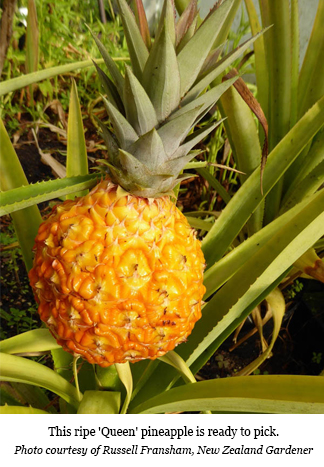by Russell Fransham, The New Zealand Gardener
Who doesn’t love pineapple? It is the quintessential tropical flavour that all other fruits are measured by, a startling mix of intense sweetness and acidity. There’s nothing quite like it.
September is time to plant out the young pups in the sunniest spot we have and time to start feeding the older plants we planted out last spring. And they like lots of feed. Rich, composty, fluffy mulch and regular feeds of diluted chicken manure or worm tea. It really helps too if the plants are against a north-facing masonry wall that reflects the heat.

The commercial pineapples you buy at the supermarket are cultivars of Ananas comosus which is a tropical, terrestrial bromeliad from South America that needs year-round warmth to thrive and fruit properly. They grow readily in a hothouse in New Zealand as long as you can keep the temperature above about 5°C on the coldest winter nights. They grow best and quickest if they’re kept around 25°C most of the time.
At home I grow a couple of delicious varieties in the hothouse: a smooth-leafed one called ‘Smooth Cayenne’ and a more vigorous one with finely serrated leaves called ‘Queen’. They are both delicious, especially if we leave them on the plant until we can smell the wonderful aroma from a couple of metres away. ‘Queen’ is the main commercial variety we used to import from New South Wales and while it grows quickly in the hothouse, fruiting after 12 to 15 months, it will also fruit outdoors here in Northland but it takes about two years because it stops growing through winter.
The red mountain pineapple, Ananas bracteatus, is a wild species from cooler altitudes in the Andes.
It grows vigorously and fruits outdoors in any warm, sunny spot in Northland and Auckland. Its reddish leaves are very spiky. As in VERY SPIKY – weeding around them is a blood sport. So it’s best to plant these through weedmat or a deep mulch to prevent weeds altogether. It is a beautiful looking plant. As the fruit develops it is brilliant red and each segment of the young fruit produces a vivid purple flower. The redness of the fruit gradually fades as it matures. It is not edible until every trace of red has gone and the skin is pale yellow. But, like any pineapple, you can smell the powerful sweet aroma when it’s ready to cut. This one takes about 18 months to produce ripe fruit outdoors here.
There is a beautiful variegated form of the red pineapple available called Ananas bracteatus ‘Tricolor’, which makes a spectacular houseplant or patio tub plant. Its fruit is also edible, though are usually smaller.
Propagating pineapples from the shoot on top of the fruit is best done in the spring or summer. Remove the shoot from the fruit by screwing it round and round until it comes free, with no flesh attached.
Let it dry out for a few days then remove the bottom few layers of scale-leaves that cover the young roots, which may already be 2cm long. Plant the shoot in sand or coarse potting mix, holding it upright with short stakes. Or you can sit it upright in the mouth of a glass of water containing a few drops of bleach, with the root end touching the water until the roots have grown a bit before planting it in the soil.
Pineapples ripen in any season. I suspect they produce a predetermined number of leaves (as do bananas) before the flower head emerges. So while all development grinds to a halt in winter, they can ripen at almost any time. A dozen to 20 plants would be likely to keep the family pineappled up all year round, but knowing my luck they’d all ripen at once and we’d end up dissolving in a puddle of pineapple juice, trying not to waste the precious fruit. Share them? Bugger that.
Source: New Zealand Gardener
